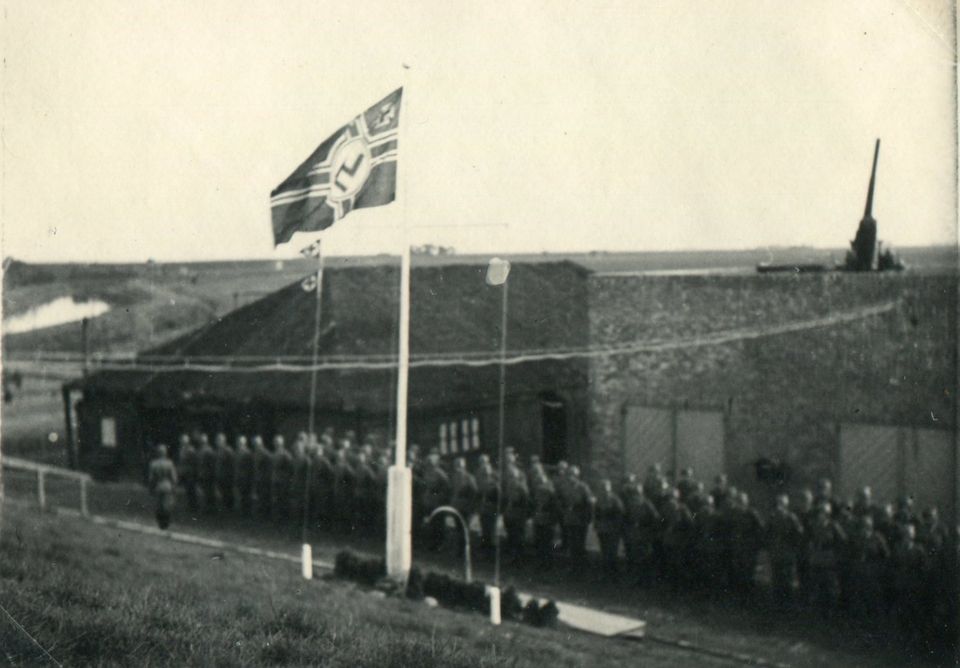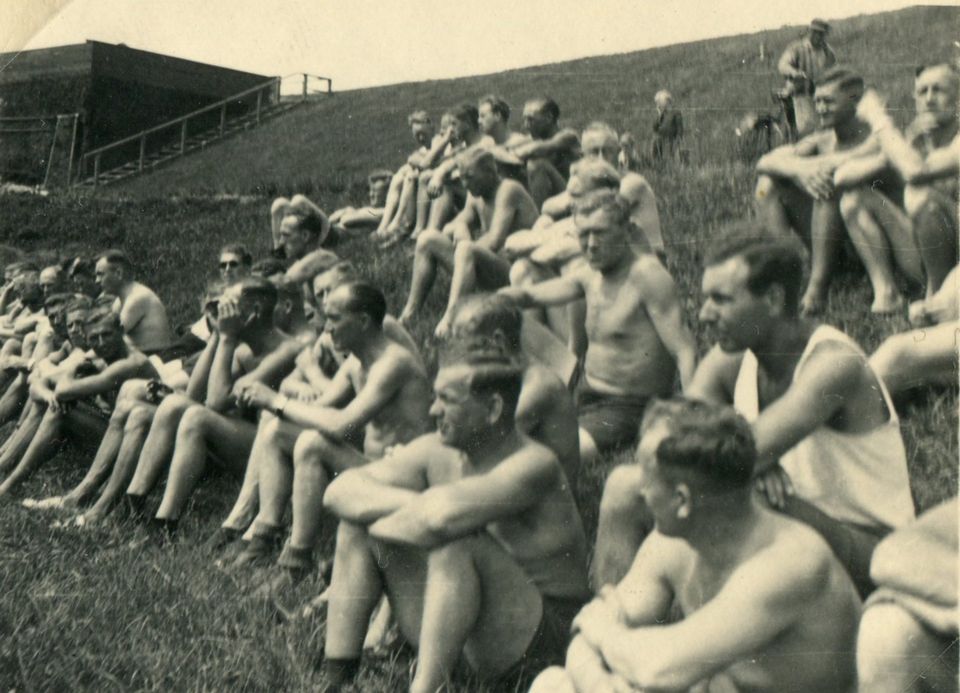Termunten during the war years
Reading time: less than 3 minutes
During World War II, the German Stützpunktgruppe Delfzijl is part of the Festung Emden. Emden is an important supply harbour for, among others, the more inland Ruhr region. The anti-aircraft artillery in and around the city provide protection for the harbour of Delfzijl, but their main purpose is to shoot down enemy fighters and bombers before they can drop their deadly load on Emden. Emden is heavily bombed and largely destroyed during the war, just as many other North German harbour cities. Although the anti-aircraft artillery (Flak) on Groninger territory is unable to prevent this, it does claim many lives in the air. The Flak batteries are the most effective way to combat allied bomber formations.
Battery Termunten. (source T. Groenewold - Oorlogsmuseum Middelstum)
With its four 12.8 cm cannons, the Flak battery in Termunten is one of the heaviest on Dutch territory, together with the one in Nansum. Initially, a lighter fortification was constructed in the area outside the dike near Punt van Reide. However, this is not a good spot to build bunkers and put heavy equipment. Storm floods and icy conditions make it inaccessible and isolated during winter.
Therefore, in 1944, the battery is moved to the dike near Fiemel, a small hamlet. Four platforms are constructed (Ringstände) for the heavy anti-aircraft artillery. These are open concrete artillery batteries mounted on a high base, three in the dike and one behind it. Concrete foundations for lighter - 10.5 cm - artillery are also constructed. A unique addition is the ammunition depot for the heavy battery type Fl 317 (Munitionsauffüllraum für 12.8 cm Flak-Batterie), the only one ever built in the Netherlands.
Advance of the Canadian army
On 28 March 1945, the II Canadian Corps begins advancing north to liberate the northern provinces, reaching the borders of Friesland and Groningen in early April. On 15 April, the first Canadian units enter Leeuwarden. They are still fighting for control of the city of Groningen at this time. On 18 April, the city is liberated and the Canadians now advance towards Delfzijl. This harbour is important for delivering supplies and the attack on Emden. Meanwhile, the German occupiers flood a large area around Delfzijl. This makes it only possible to attack from the south via a narrow piece of land along the Eems. It is here that the Canadian army first encounters the battery near Fiemel.
Military men on the dike near Fiemel, Battery Termunten. (source T. Groenewold - Oorlogsmuseum Middelstum)
The battle of Delfzijl
The artillery in the Flak batteries is also capable of firing at ground-level targets. Their reach in the air is about 15 kilometres, but horizontally it exceeds 20 kilometres. The battle of Delfzijl lasts from 23 April to 2 May. The Germans defend the last piece of the occupied Netherlands with all their might. Fighting around the city and the defence lines is fierce. 88 civilians, 102 Canadian and 185 German soldiers lose their lives in the battle. The villages in the area are severely damaged and people are forced to flee. Hundreds of people find refuge in Finsterwolde, which has already been liberated, and Winschoten. During the night of 1 to 2 May, the Germans finally surrender. They quietly disappear to the other side of the Eems where they continue the battle.
Dollart Süd Battery
Another battery in Groningen was the Dollart Süd Battery in the Carel Coenraadpolder, behind the village Hongerige Wolf near Finsterwolde. Dollart Süd was constructed to protect Emden and the estuary of the Eems. Just like the battery at Termunten, this one also had Flak artillery; four heavy cannons (10.5 cm). Several barracks were built near the coastal battery in where approximately 150 members of the German navy artillery were camped. The Dollart Süd Battery had to be on stand-by 24 hours per day in order to shoot down aeroplanes.
On the night of 24 to 25 April, during the liberation of Delfzijl, the battery was taken out by heavy Canadian artillery. The wooden barracks also burned down. Because there were no bunkers, the Germans were not able to defend themselves properly. The Allied Forces were able to take 80 Germans prisoner; the rest fled to Germany.
After the war, the battery was replaced by an internment camp for members of the National Socialist Movement. In 1948, however, the camp was closed due to neglect and abuse. After 1949, a new barrack camp was built near the site of the former battery, which was first used for prisoners doing excavation works. The camp was also later used to house eighty soldiers of the Royal Netherlands East Indies Army and their families, also called 'Ambonese'. The barracks were torn down in 1962 and a forest was planted. This is known colloquially as the Ambonese forest. The former German ammunition depot has been converted into a holiday home called ‘Dollart Süd’. The Groninger Landschap has built four beautiful cabins across from the Ambonese forest, where cyclists can spend the night when travelling along the coast.
An 8,000 hectare nature reserve contains the remains of the Flak battery Termunten, which the Germans used for the anti-aircraft defence of Emden. Here, the Groninger Landschap tells the tale of nature, landscape and military heritage.
Starting at the nature organisation’s visitor centre, you can walk along several routes with visible and less-visible remains of the Atlantic Wall. Visitors can experience these memories of the war in various ways. An outlook point at the visitor centre gives an overview of the entire fortification.
Visit Termunten

